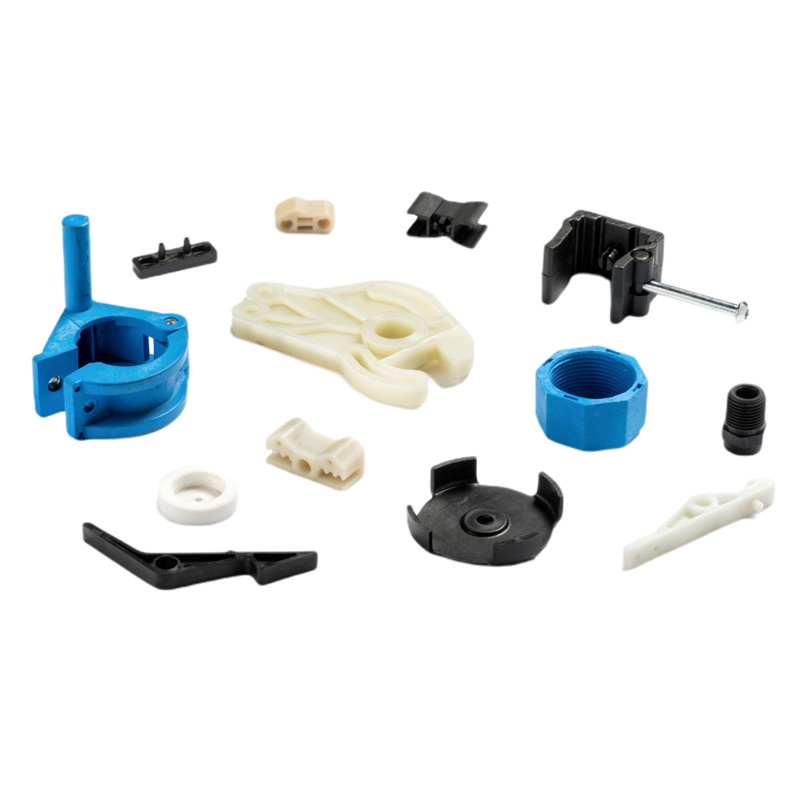
1. Our Capabilities for Youlin®Injection Plastic Parts
We have 30+ injection molding machines from 80T to 470T that can produce common size injection molded parts. The tonnage calculation/clamping force is one of the key factors for quality and cost. It keeps the tooling closed during the injection process. The higher tonnage, the higher weight of tooling it can keep.

2. Advantages of Youlin® Injection Plastic Parts
● Production Grade Tooling: Production-grade steel tooling with T1 samples delivered within a week. Once your mold is created, Youlin sends ten samples (T1) for approval.
● Broad Material Selection: Choose from dozens of materials including ABS, Ultem, PC/ABS, PEEK, HDPE, PET, TPE, PET, nylon, polyethylene, and more
● Precision: Industry-leading delivery on tight tolerance projects
● Scalability: Mold prototypes or production runs of millions of parts
● Wide Range of Machines: Single, multi-cavity, and family molds; 50 to 1,100+ press tonnage; side actions including hand-loaded cores available
3. Process Steps for Injection Plastic Parts

A. The tool closes, signifying the start of the injection molding cycle. Resin pellets are fed from a hopper into the barrel.
B. The screw rotates to auger the pellets forward toward the tool. The resulting friction plus barrel heaters cause the pellets to melt. The screw is pushed forward and injects the material at the force and speed necessary to properly fill the tool cavity. During this step, it is imperative that displaced air escape through the vents and parting line designed into the tool for this purpose. Miscalculation or malfunction of these air release points could introduce defects and waste.
C. After the tool cavity is filled, the resin must be allowed to cool. Water is cycled through the tool to maintain a consistent temperature while the material hardens. Cooling times vary based on the plastic used and part thickness.
D. While the injection-molded plastic part is cooling within the tool, the screw retracts and reloads with melt in preparation for the next injection. Heaters within the barrel screw keep the melt plasticized at its designated temperature.
E. Once the molded material reaches its ideal ejection temperature, the tool opens and the part is pushed out by the forward motion of the ejector rod and pins. The part can be extracted by a robot, manual operator, or falls freely into a bin underneath the tool.
F. Sometimes, the molded parts have pieces attached called runners. Runners are simply extraneous material that gathers in the channels that the melt takes on its way to filling the tool cavity. Runners are either manually or robotically detached from the usable part, and usually ground and recycled to reduce costs and protect the environment. The injection-molded plastic parts are ready for inspection, packaging, and shipment.
4. Material Property of Injection Plastic Parts
Youlin provides various materials for your choice.
|
Polystyrene/PS and modified polystyrene/HIPS: Good fluidity for easier processing; Good dimensional stability; Easier coloring; High brittleness for poor shock resistance; Can be scratched on the surface easily; Poor acid resistance for crazing; |
Polymethyl methacrylate/PMMA/Acrylic: Burning slowly; High transparency; Forming easily; Scratching easily |
|
Propylene - butadiene - styrene polymers/ABS: The best electroplate ability among plastics; The ingredient of butadiene improve the shock resistance greatly; Good surface gloss; Low shrinkage for reliable dimension; Organic solvent intolerance, can be dissolved into emulsion when combining with ketone, ester, aldehyde, and chlorinated hydrocarbon |
Polyamide/PA/Nylon - Crystalline plastics: Good toughness; Good wear resistance; Good fatigue resistance; Good self-lubrication; Good self-extinguishment; Good strength of extension; High water absorption |
|
Polyformaldehyde/POM - Crystalline plastics: Comprehensive mechanical performance; High rigidity and hardness; Excellent worn resistance and self-lubrication; Organic solvent tolerance; Low moisture that can maintain stable dimension; Low acid resistance; Low adhesiveness; |
Polyvinyl chloride/PVC: It is soluble in cyclohexanone and dichloroethane; The softness of range can be extended after plasticizer is added; Good fire resistance; High shrinkage of soft PVC(1-2.5%); The PVC molecule absorbs water easily so that it needs to be dry before forming; |
|
Polyethylene/PE - Crystalline plastics: Usually used for blow molding products; Its chemical properties are reliable that can’t be dissolved into any solvent under room temperature; Good toughness and extensibility even at low temperature; Poor mechanical strength; Low adhesiveness; Scratch on the surface easily; |
Polycarbonate/PC - Crystalline plastics: The best plastic of shock resistance; Low forming shrinkage(0.05-0.7%) that the end-part is precise and the dimension is stable; Burning slowly; Can be dissolved in organic solvent such as alkali, ketone, aromatic hydrocarbon, etc. Poor fatigue resistance; Significant ESCR; |
|
Polypropylene/PP - Crystalline plastics: Lightweight; High tensile strength; Good formability; Good wear resistance; Shock resistance under room temperature; High forming shrinkage(1.6%) that plastic part can be deformed and shrink easily; Low adhesiveness; |
|
5. Surface Treatment for Injection Plastic Parts
|
● Spray painting ● Silk-screen ● Transfer-printing ● Electroplating ● Laser etching ● Anodizing ● Scouring/brushing |
● High glaze ● UV-finish ● Embossing ● Polishing ● Cleaning ● Bake finish ● Fuming PC |
6. FAQ
Q: What is plastic injection moulding process?
A: Plastic injection moulding is the process of melting plastic pellets (thermosetting/ thermoplastic polymers) that once malleable enough, are injected at pressure into a mould cavity, which fills and solidifies to produce the final product.
Q: What are the 6 main types of plastic?
A: #1 Polyethylene Terephthalate (PET)
#2 High-Density Polyethylene (HDPE)
#3 Polyvinyl Chloride (PVC)
#4 Low-Density Polyethylene (LDPE)
#5 Polypropylene (PP)
#6 Polystyrene (PS)
Q: What are plastic molds made of?
A: Plastic injection molds are typically constructed from hardened or pre-hardened steel, aluminum, and/or beryllium-copper alloy. Steel molds cost more, but are often preferred because of their high durability.